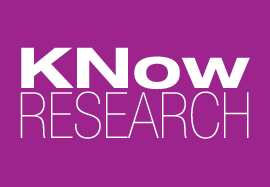Stretching Beyond the Comfort Zone
After nearly 20 years as a consumer insights professional, I was starting to think I’d seen and done it all. Of course, that’s not even remotely true, and there’s always something new to learn when it comes to human behavior. But at the end of last year, that’s just the truth of how I was feeling. I could tell I was at risk of going through the motions and falling into a trap of complacency, and I knew I needed to shake things up. I committed to connecting with a beginner’s mindset in order to reignite my passion and curiosity in my chosen career.
I decided I needed to take a bold action to get back on course, do something that felt scary and challenging, and that required a big personal commitment. So, this past winter, I enrolled in a 12-week virtual Design Thinking Executive Education Program at the prestigious Stanford Graduate School of Business, hosted by edtech giant, Great Learning. The course was led by renowned Professor Stefanos Zenios who launched Stanford’s popular “Startup Garage” entrepreneurship course that has birthed over 130 successful new ventures, including DoorDash. In other words, this is a professor who knows what he’s talking about, and it was such a privilege to learn from him.
My program peers included successful entrepreneurs, MDs, Attorneys, Non-Profit leaders, policymakers, and business professionals from around the globe. From the start, I wondered if I was in over my head. Could I really hold my own amongst classmates who held multiple advanced degrees, who spoke multiple languages, or who had started million-dollar companies? I am proof that even career veterans can get caught up in feelings of imposter syndrome.
Besides the occasional webinar, industry conference, and company training, I hadn’t completed anything close to a formal, structured academic program in two full decades. Heck, I didn’t have a laptop – or even a cell phone – the last time I was enrolled in university.
But, I didn’t give up. I committed 8 hours a week for a full quarter of coursework, on top of a full-time workload, to formally immerse myself in the world of Design Thinking.
For the uninitiated, Design Thinking is a creative, iterative, human-centered problem-solving process. It begins with building empathy and understanding of the needs of whoever the “end user” will be. Then, the process moves into imagining potential solutions, and prototyping and testing solutions with end-users. In some circles, Design Thinking is referred to as the “4-Ds Framework” (Discover, Define, Develop, and Deliver).
Here are 4 lessons and reminders that I took away from my back-to-the-classroom venture into Design Thinking…
- The very best solutions begin with a relentless focus on the customer…and that focus should remain steadfast throughout. As a consumer researcher, I am well versed in the importance and value of customer centricity. Hearing this lesson reinforced in every single lecture was heartening. I went “back to basics” on how to design a clearly-considered observation plan, and I was reminded of the deep power of pure ethnography – observing users “fly-on-the-wall-style” – in their natural environments, without interfering. I tested out different interview styles with multiple participants in 1-1 conversations to uncover their unmet needs in an open-ended, non-biasing way. And I played with a variety of techniques to then cull my findings into empathy maps, personas, customer journeys, and white spaces. Building empathy and understanding the customer from many angles is the difference between a mediocre solution and a great solution.
- “How Might We…” statements are magical! HMWs are an excellent tool to reframe challenges, problems, or barriers in a way that is approachable, collaborative, and motivational. And, they can be used and revisited throughout a design challenge, from defining the initial challenge itself to exploring knowledge gaps and facilitating team ideations. HMW statements are a great way to stay anchored and optimistic about the end-game.
- An Ideation is not a “Sales Pitch.” We’ve all heard that the idea generation portion is not the place necessarily to rain on the parade. BUT, it’s also not a place to “sell” your idea to the team, no matter how great you think it is. Ideation is not a sales pitch competition. It’s about getting all potential ideas out in the open, regardless of your powers of persuasion. This course served as a healthy reminder of the importance of simply presenting a potential idea and how it would work, and then it’s on to the next. Let the idea speak for itself without a lot of extra fanfare, and at the end of the session, see what rises to the top in the final votes.
- Rapid Prototyping is an Attitude, not just a step in the process. I’ll admit that prototyping was the most intimidating learning module for me in the course. But I learned that prototyping does not (and should not) be a big budget, lengthy, cumbersome undertaking that can only be tackled by fancy, high-tech product developers or engineers. The point of prototyping is to “fail fast” so you can “improve fast.” Prototypes are nothing more than conversation starters that help make the hypothetical real and help users better visualize and understand the experience. I learned how to stretch beyond static concepts and design interactive mockups. I tested out techniques with fun names like Mechanical Turks, Smoke Screens, Pinocchios, and One Night Stands. And, if you’re curious, you can learn a bit more about some of these techniques by checking out the book, The Right It by Alberto Savoia.
Participating in the 12-week Design Thinking Course accomplished exactly what I hoped it would. It helped to re-spark my curiosity, it challenged and grew my skills as an insight professional, and it gave me the knowledge and confidence to get more creative in my approach to working with clients.
Am I ready to sign up for another big course? Ha! Not yet. But, I definitely won’t let another 20 years pass without getting back to the classroom to gain some outside inspiration and keep me on my toes.
What’s something new and inspiring you’ve learned or experienced recently that has helped reignite, or affirm, your career passion? We’d love to hear about it!

